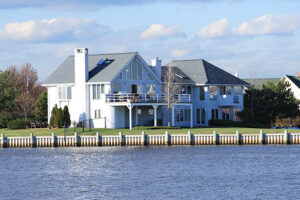Waterfront homes are a dream for many—offering stunning views, recreational opportunities, and a peaceful lifestyle. However, financing a waterfront property can be more complex than a traditional home purchase. If you’re thinking of investing in a home by the water, here’s what you need to know before applying for a mortgage.

1. Expect Higher Prices and Larger Down Payments
Waterfront homes typically cost more due to their desirable location. Because of this, lenders may require a larger down payment—often 20% or more. Luxury properties may even need a jumbo loan, which comes with stricter credit and income requirements.
2. Know the Difference Between Primary, Secondary, and Investment Properties
How you plan to use the property affects your loan options:
-
Primary residence loans offer the best terms and rates.
-
Second homes (vacation properties) often require a higher down payment and interest rate.
-
Investment properties have even more stringent criteria.
Make sure you’re clear on your intended use before talking to a lender.
3. Check for Flood Zone Requirements
Waterfront homes are often in flood-prone areas, which means flood insurance may be mandatory. This can significantly impact your monthly costs. Some lenders will also factor flood risk into their approval decision, so it’s essential to research this early in the process.
4. Shop for Lenders Familiar with Waterfront Properties
Not all mortgage lenders are experienced with financing waterfront real estate. Look for lenders who specialize in these types of loans and understand the added complexities like shoreline regulations, dock permits, and insurance requirements.
5. Get a Comprehensive Home Inspection
Waterfront homes are exposed to harsher elements—salt, moisture, wind—which can cause faster wear and tear. A detailed home inspection (and sometimes additional specialized inspections) is vital before finalizing financing.
6. Consider Total Ownership Costs
Beyond the mortgage, remember to factor in:
-
Flood and homeowners insurance
-
Property taxes (often higher on waterfront properties)
-
HOA or community maintenance fees
-
Upkeep for seawalls, docks, or erosion control
Final Thoughts
Financing a waterfront home requires extra planning and preparation, but the rewards of owning a piece of paradise are well worth it. Work with a knowledgeable real estate agent and lender to navigate the process smoothly—and enjoy the journey to life on the water!
Kim Beiningen is a real estate agent in St. Pete Beach, Florida and the surrounding area.
For more information, visit our web site https://kimbeiningen.com/ or call (727) 244-8372.


